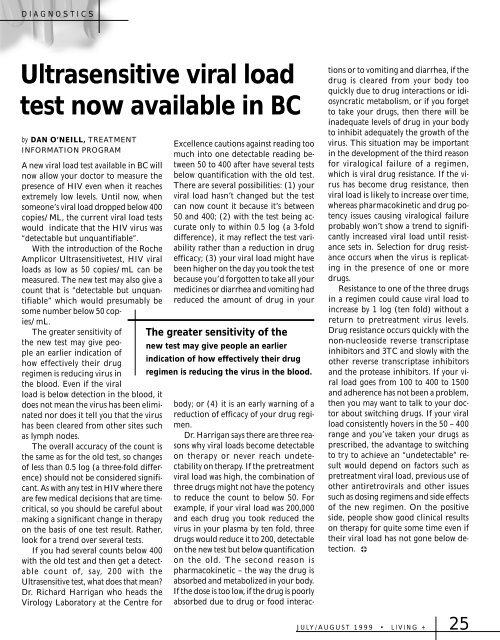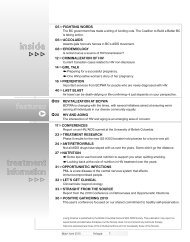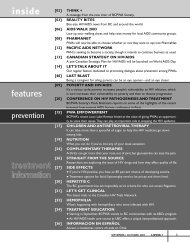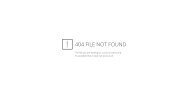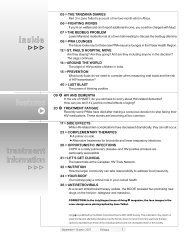Living + Magazine Issue 1 - Positive Living BC
Living + Magazine Issue 1 - Positive Living BC
Living + Magazine Issue 1 - Positive Living BC
Create successful ePaper yourself
Turn your PDF publications into a flip-book with our unique Google optimized e-Paper software.
DIAGNOSTICS<br />
Ultrasensitive viral load<br />
test now available in <strong>BC</strong><br />
by DAN O’NEILL, TREATMENT<br />
INFORMATION PROGRAM<br />
A new viral load test available in <strong>BC</strong> will<br />
now allow your doctor to measure the<br />
presence of HIV even when it reaches<br />
extremely low levels. Until now, when<br />
someone’s viral load dropped below 400<br />
copies/ML, the current viral load tests<br />
would indicate that the HIV virus was<br />
“detectable but unquantifiable”.<br />
With the introduction of the Roche<br />
Amplicor Ultrasensitivetest, HIV viral<br />
loads as low as 50 copies/mL can be<br />
measured. The new test may also give a<br />
count that is “detectable but unquantifiable”<br />
which would presumably be<br />
some number below 50 copies/mL.<br />
The greater sensitivity of<br />
the new test may give people<br />
an earlier indication of<br />
how effectively their drug<br />
regimen is reducing virus in<br />
the blood. Even if the viral<br />
load is below detection in the blood, it<br />
does not mean the virus has been eliminated<br />
nor does it tell you that the virus<br />
has been cleared from other sites such<br />
as lymph nodes.<br />
The overall accuracy of the count is<br />
the same as for the old test, so changes<br />
of less than 0.5 log (a three-fold difference)<br />
should not be considered significant.<br />
As with any test in HIV where there<br />
are few medical decisions that are timecritical,<br />
so you should be careful about<br />
making a significant change in therapy<br />
on the basis of one test result. Rather,<br />
look for a trend over several tests.<br />
If you had several counts below 400<br />
with the old test and then get a detectable<br />
count of, say, 200 with the<br />
Ultrasensitive test, what does that mean?<br />
Dr. Richard Harrigan who heads the<br />
Virology Laboratory at the Centre for<br />
Excellence cautions against reading too<br />
much into one detectable reading between<br />
50 to 400 after have several tests<br />
below quantification with the old test.<br />
There are several possibilities: (1) your<br />
viral load hasn’t changed but the test<br />
can now count it because it’s between<br />
50 and 400; (2) with the test being accurate<br />
only to within 0.5 log (a 3-fold<br />
difference), it may reflect the test variability<br />
rather than a reduction in drug<br />
efficacy; (3) your viral load might have<br />
been higher on the day you took the test<br />
because you’d forgotten to take all your<br />
medicines or diarrhea and vomiting had<br />
reduced the amount of drug in your<br />
The greater sensitivity of the<br />
new test may give people an earlier<br />
indication of how effectively their drug<br />
regimen is reducing the virus in the blood.<br />
body; or (4) it is an early warning of a<br />
reduction of efficacy of your drug regimen.<br />
Dr. Harrigan says there are three reasons<br />
why viral loads become detectable<br />
on therapy or never reach undetectability<br />
on therapy. If the pretreatment<br />
viral load was high, the combination of<br />
three drugs might not have the potency<br />
to reduce the count to below 50. For<br />
example, if your viral load was 200,000<br />
and each drug you took reduced the<br />
virus in your plasma by ten fold, three<br />
drugs would reduce it to 200, detectable<br />
on the new test but below quantification<br />
on the old. The second reason is<br />
pharmacokinetic – the way the drug is<br />
absorbed and metabolized in your body.<br />
If the dose is too low, if the drug is poorly<br />
absorbed due to drug or food interactions<br />
or to vomiting and diarrhea, if the<br />
drug is cleared from your body too<br />
quickly due to drug interactions or idiosyncratic<br />
metabolism, or if you forget<br />
to take your drugs, then there will be<br />
inadequate levels of drug in your body<br />
to inhibit adequately the growth of the<br />
virus. This situation may be important<br />
in the development of the third reason<br />
for viralogical failure of a regimen,<br />
which is viral drug resistance. If the virus<br />
has become drug resistance, then<br />
viral load is likely to increase over time,<br />
whereas pharmacokinetic and drug potency<br />
issues causing viralogical failure<br />
probably won’t show a trend to significantly<br />
increased viral load until resistance<br />
sets in. Selection for drug resistance<br />
occurs when the virus is replicating<br />
in the presence of one or more<br />
drugs.<br />
Resistance to one of the three drugs<br />
in a regimen could cause viral load to<br />
increase by 1 log (ten fold) without a<br />
return to pretreatment virus levels.<br />
Drug resistance occurs quickly with the<br />
non-nucleoside reverse transcriptase<br />
inhibitors and 3TC and slowly with the<br />
other reverse transcriptase inhibitors<br />
and the protease inhibitors. If your viral<br />
load goes from 100 to 400 to 1500<br />
and adherence has not been a problem,<br />
then you may want to talk to your doctor<br />
about switching drugs. If your viral<br />
load consistently hovers in the 50 – 400<br />
range and you’ve taken your drugs as<br />
prescribed, the advantage to switching<br />
to try to achieve an “undetectable” result<br />
would depend on factors such as<br />
pretreatment viral load, previous use of<br />
other antiretrovirals and other issues<br />
such as dosing regimens and side effects<br />
of the new regimen. On the positive<br />
side, people show good clinical results<br />
on therapy for quite some time even if<br />
their viral load has not gone below detection.<br />
JULY/AUGUST 1999 • LIVING + 25


